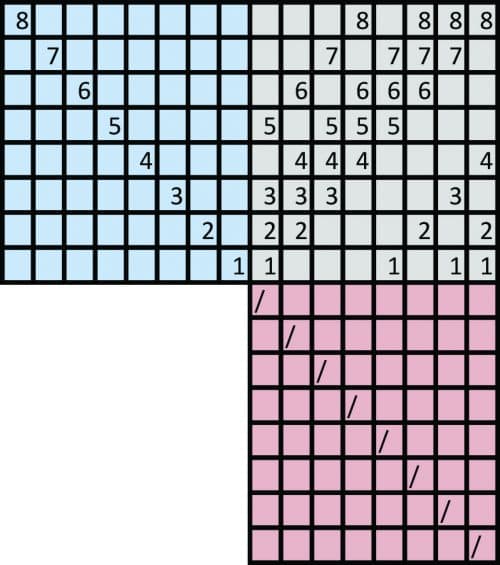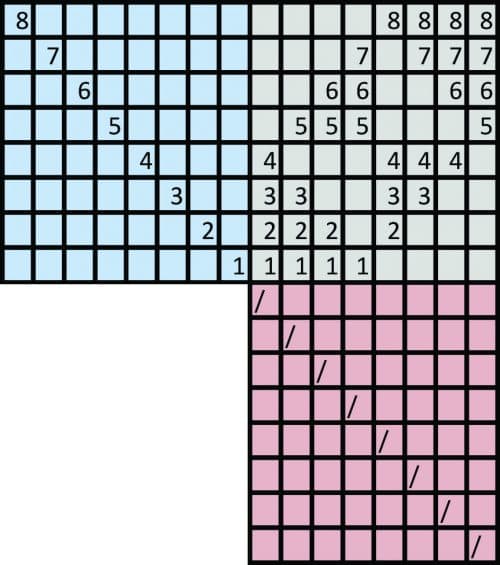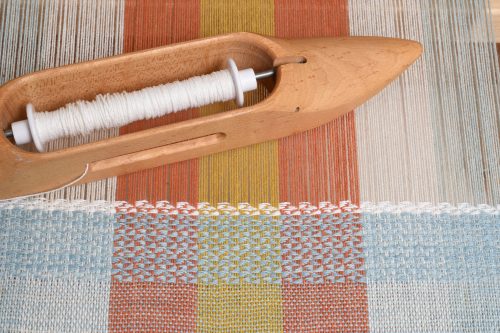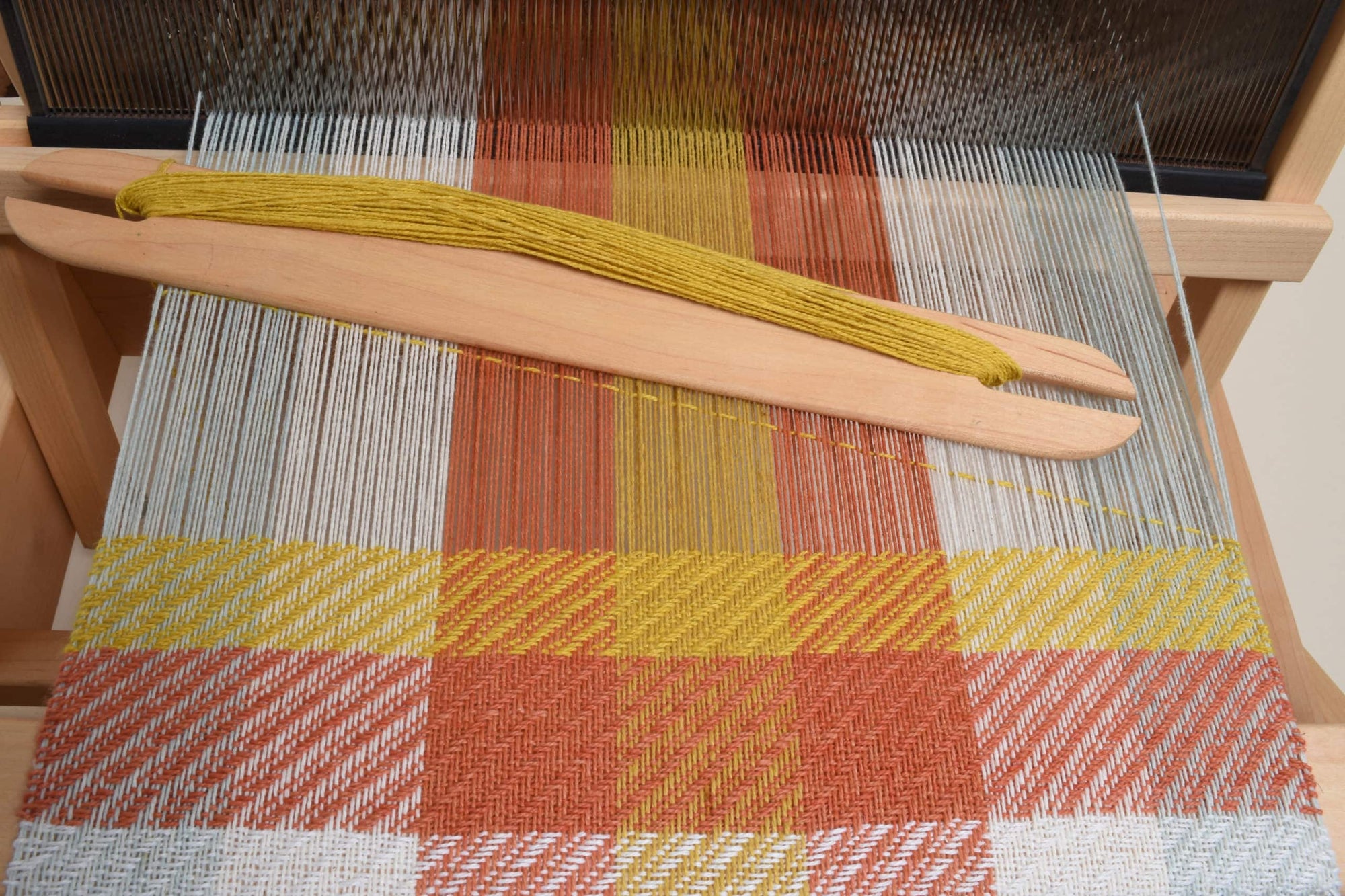Progressing from a Rigid Heddle Loom to a Shaft Loom
By Jane Patrick
For the past 10 years, I’ve been weaving on the Flip or Cricket loom, exploring and writing about rigid heddle weaving. Now I’m yearning to get back to working with shafts (also called harnesses) to study weave structures again.
Shaft Looms vs. Rigid Heddle Looms
If you are currently weaving on a rigid heddle loom, the difference between a rigid heddle loom and a shaft loom is that you have more pattern possibilities. On a rigid heddle loom, you create patterns with either a pick-up stick or by using finger-controlled weaves. (You can check out my book, The Weaver’s Idea Book, to see the vast possibilities that the rigid heddle loom has to offer.)
On a shaft loom you have shafts, or harnesses, that hold heddles. To thread the loom, you thread the reed that determines the sett (number of warp ends per inch) and then separately thread the heddles. The pattern is determined by the order in which you thread the heddles on the shafts. For example, you might thread the first thread in a heddle on shaft 1, the next thread in a heddle on shaft 2, and so on.
Different than a rigid heddle loom where you can change the pattern by changing the pick-up stick, once you have the pattern threaded on a shaft loom, you can’t change it. What you can do, though, is change how you weave the pattern.
On a shaft loom, once you have the pattern threaded, you have the option of how you are going to lift the shafts. Let’s say that on a 4-shaft loom, you have threaded the shafts in what’s called a straight draw: 1,2,3,4; 1,2,3,4; repeat. To weave this you might lift shafts 1-2 together, 2- 3 together, then 3-4, then 1-4. This would weave what’s called a 2-2 twill. But you could change this pattern by changing the combination of shafts that are lifted. For example you could lift 1-2-3, 2-3-4, 3-4-1, 4-1-2. This is also a twill pattern, but it is called a 3-1 twill.
What I’ve given you is a very broad overview. To delve deeper, I recommend Deborah Chandler’s Learning to Weave. Working through this book is just like taking a class with this encouraging and knowledgeable teacher.
Deborah really understands the different weave structures and is able to explain how to weave, for example, summer & winter, overshot, or Bronson lace (if these names intrigue you then you are on the way to exploring shaft loom weaving).
Up to now I’ve referred to just “shaft loom”. A shaft loom could be a table loom or a floor loom. A table loom is what it sounds like, a loom that sits on a table with levers for lifting the shafts. Table looms are wonderful for learning about weave structure because it is easy to change the pattern by using different levers.
Examples of Schacht floor looms are the Wolf Pup, Baby Wolf, Mighty Wolf, and Standard Floor Loom. Floor looms are handy because they have treadles, or pedals, which you push with your feet to move the shafts, leaving your hands free to throw the shuttle and beat in the weft. All these looms come with 4 or 8 shafts. Essentially the more shafts, the more pattern possibilities (see book resources in the accompanying article).
An 8-shaft Twill Pattern
On my journey back to shaft loom weaving, I decided I’d start exploring 8-shaft twill, threading up an 8-shaft table loom for a set of luncheon napkins, weaving a different weft sequence with each napkin. The yarn I chose was one I’ve wanted to use for a long time. It is a beautiful unmercerized 8/2 cotton from Mayan Hands that is commercially spun in Guatemala and hand-dyed with natural dyes by the Mayan Hands cooperative and available in kit form from Cotton Clouds.
To try out the colors, I threaded up broad stripes and wove the weft colors in the same way, creating a plaid. I love how the colors play against each other. This kit is sold as a kitchen towel yarn kit—but you don’t have to use the yarn this way!

Project Specs
Weave structure: 8-shaft twill
Width in reed: 11-3/8"
EPI: 20 (2 ends sleyed together in 10-dent reed)
PPI: 20 for a balanced weave
What You'll Need
-
8/2 unmercerized cotton from Mayan Hands, in 4 colors
-
8-shaft loom, at least 12” weaving width
-
10 dent reed
Materials
Equipment
Directions
Warp the loom in the following color order: 34 blue, 32 white, 32 orange, 32 gold, 32 orange, 32 white, 34 blue.
I also put a floating selvedge on each edge, which is a warp thread at each selvedge (in this case the floating selvedges are doubled) threaded through the reed but not a heddle, thus floating midway in the shed.
When you enter the shed you go over the floating selvedge. When you exit the shed you go under the floating selvedge. After a while it becomes an automatic motion that you don’t even notice. A floating selvedge is a good idea when you are weaving a structure where the edge thread is not caught every other row.
Here’s how I threaded up my loom in a straight draw: 1,2,3,4,5,6,7,8. In blue box across the top is the threading. This tells you that you are going to thread the first thread on shaft 1, the second on shaft 2, and so on. You repeat this for as many times as needed. In this case you will repeat the threading 28 times (don’t forget that the first 2 threads and that last two threads will not be threaded in a heddle).
The purple square is what’s called the tie-up. This tells you which shafts you will operate with each row of weaving. On a floor loom each column represents a treadle to which the shafts are tied, creating the lift pattern. On a table loom, as I’ve done here, you will pull down the necessary levers in each column. In this example, the first row of weaving, you will pull down levers 1,2,3 and 5. On the next row, you’ll pull down 2,3,4 and 6, and so on.

Finally the red vertical column represents the treadling, or the order in which the shafts are lifted. In this first example, I’ve repeatedly woven 1,2,3,4,5,6,7,8—which makes a straight twill. You can see that the weaving makes a diagonal line in one direction.

For the next sample, you can see what happens when I changed the tie-up. The threading and the treadling are the same. I've only changed the tie-up box--a super easy thing to do on a table loom.

This is just the beginning of my pattern explorations. I hope you will be inspired to try something new in 2017.


